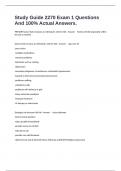Study Guide 2270 Exam 1 Questions
And 100% Actual Answers.
PRIMARY factor that increases an individual's risk for falls - Answer -history of falls (especially within
the last 3 months)
factors that increase an individual's risk for falls - Answer -age over 65
-poor vision
-multiple medications
-memory problems
-behaviors such as rushing
-depression
-secondary diagnoses: incontinence; orthostatic hypertension
-hazards in the home/community/environment
-problems walking
-ambulatory aids
-problems with balance or gait
-lower extremity weakness
-improper footwear
-IV therapy or saline locks
Strategies to decrease fall risk - Answer -clear pathways
-bed in lowest position
-wipe up spills immediately
-provide access to call bell
-educate to call
-provide non-skid footwear
-determine pt risk of fall with Morse Fall Scale and BMAT Mobility Assessment
,What actions are necessary for the nurse to take before repositioning a patient in the bed? - Answer -
safety is the first priority
-ask pt to help as much as possible
-determine if pt comprehends what is expected
-determine pt's comfort level
-determine if you nee extra assistance
Supine and it's pressure points - Answer -lying on back
-back of head, shoulder, elbow, sacrum, heels
Fowler's and it's pressure points - Answer -sitting up
-back of head, shoulder, lower back, sacrum, heels
Semi-fowler's and it's pressure points - Answer -slightly sitting up
-back of head, shoulder, lower back, sacrum, heels
Prone and it's pressure points - Answer -lying on stomach
-head, chin, elbow, chest, reproductive organ, knee, toes
Side-lying and it's pressure points - Answer -lying on side with opposite knee bent
-ear/side of head, shoulder, elbow, Trochanter/hip, anterior iliac spine, lateral and medial side of knee
(pressing against other leg), lateral and medial ankle
SIMS and it's pressure points - Answer -lying on left side with right knee bent
-ileum, humerus, clavicle, knees, and ankles
What are metabolic complications of impaired mobility? - Answer -decreases in order to preserve
energy
-endocrine: maintains homeostasis
-calcium absorption (bone density) - electrolyte imbalance
,-GI function - decrease in peristalsis
What are respiratory complications of impaired mobility? - Answer -have the pt breathe deep and
cough
-atelectasis: collapsing of alveoli
-hypostatic pneumonia: pooling of respiratory secretions
What are cardiovascular complications of impaired mobility? - Answer -orthostatic hypotension -
powler (pale), light-headed, fainting; BP drops more than 20mmHg in the systolic or diastolic drops more
than 10mmHg
-increased cardiac workload - heart doesn't pump efficiently = more O2 used
-thrombus (blood clot in arteries) - accumulation of platelets, fibrin, clotting factor
-edema: pooling of blood in lower limbs
What are musculoskeletal complications of impaired mobility? - Answer -loss of endurance and muscle
mass and decreased stability and balance
What are muscle complications of impaired mobility? - Answer -loss of muscle mass
-muscle atrophy
What are skeletal complications of impaired mobility? - Answer -impaired calcium absorption
-joint abnormalities
-disuse osteoporosis: bones get weak
-foot drop: permanent plantar flexion = no walking
What are urinary elimination complications of impaired mobility? - Answer -urinary stasis: lack of urine
flow = infection
-renal calculi: kidney stones
-urinary reflux: urine backflow while laying down
-CAUTI
, What are integumentary complications of impaired mobility? - Answer -pressure ulcer
-ischemia: tissue swells and dies from not enough blood flow or not enough oxygen
What are psychosocial complications of impaired mobility? - Answer -change from what they're "used
to"
What are the principles of Standard Precautions? - Answer set of infection control practices
-hand hygiene
-use PPE whenever there is possible exposure to infectious material
-follow respiratory hygiene/cough etiquette principles
-ensure appropriate patient placement
-properly handle and properly clean and disinfect patient care equipment
Factors that influence wound healing - Answer -nutrition: needs calories and protein
-tissue perfusion: lacking O2
-infection
-age: older ages take longer to heal
-psychosocial impact of wounds, body image changes
-size (length and width), depth, color of wound = staging of wound
serous drainage - Answer clear, watery plasma
sanguinous drainage - Answer -bloody drainage
-indicates active bleeding
serosanguineous drainage - Answer thin, watery most common type in surgical wound
-mixture between serous and sanguineous
-pale, red, pink




